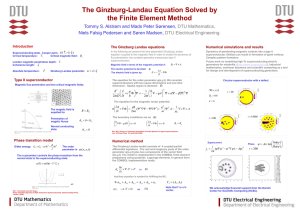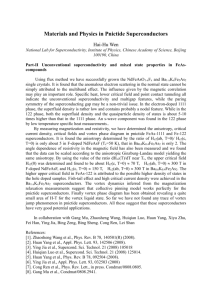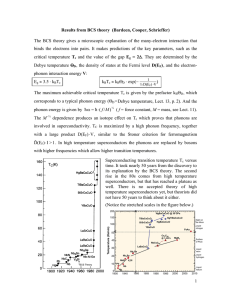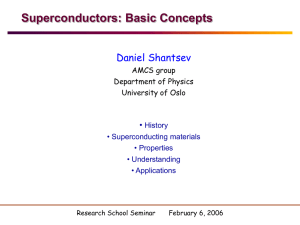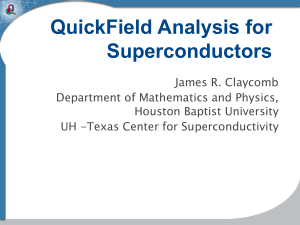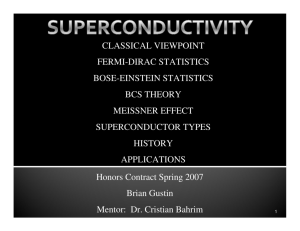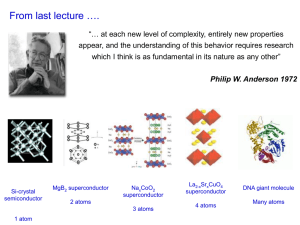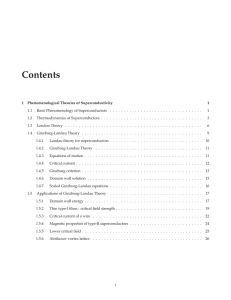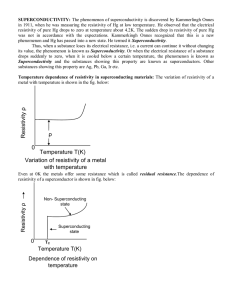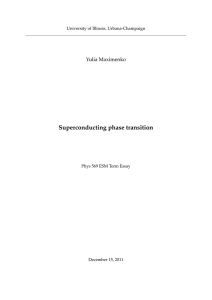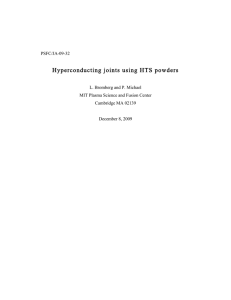PHZ 7427 Spring 2010 – Homework 5
advertisement
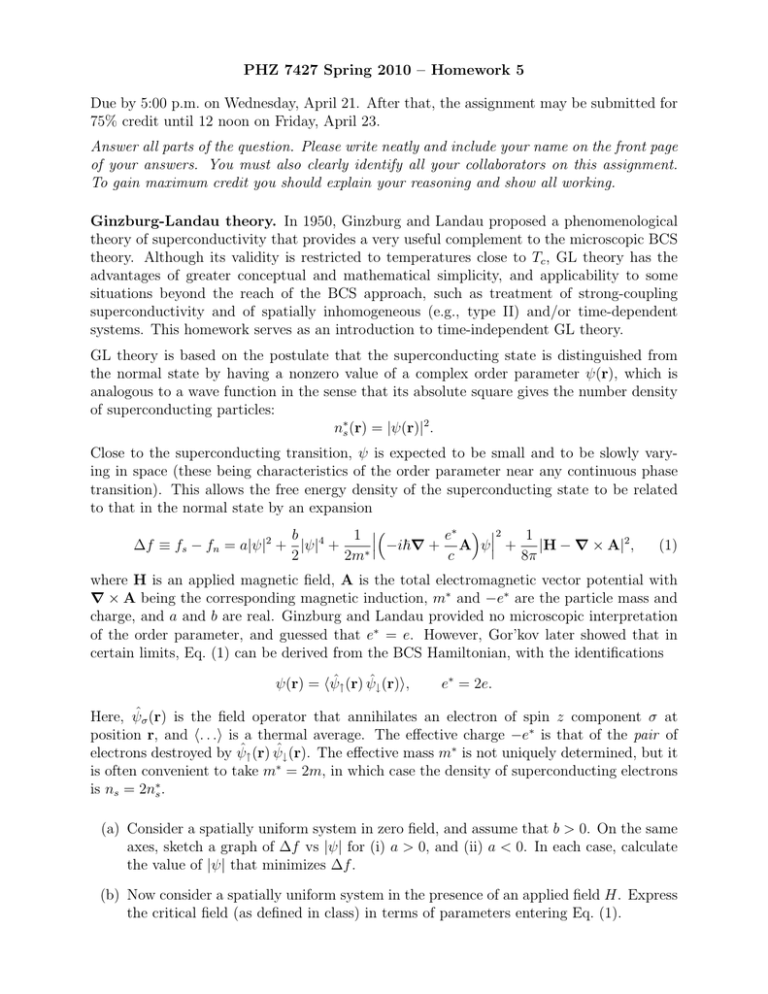
PHZ 7427 Spring 2010 – Homework 5 Due by 5:00 p.m. on Wednesday, April 21. After that, the assignment may be submitted for 75% credit until 12 noon on Friday, April 23. Answer all parts of the question. Please write neatly and include your name on the front page of your answers. You must also clearly identify all your collaborators on this assignment. To gain maximum credit you should explain your reasoning and show all working. Ginzburg-Landau theory. In 1950, Ginzburg and Landau proposed a phenomenological theory of superconductivity that provides a very useful complement to the microscopic BCS theory. Although its validity is restricted to temperatures close to Tc , GL theory has the advantages of greater conceptual and mathematical simplicity, and applicability to some situations beyond the reach of the BCS approach, such as treatment of strong-coupling superconductivity and of spatially inhomogeneous (e.g., type II) and/or time-dependent systems. This homework serves as an introduction to time-independent GL theory. GL theory is based on the postulate that the superconducting state is distinguished from the normal state by having a nonzero value of a complex order parameter ψ(r), which is analogous to a wave function in the sense that its absolute square gives the number density of superconducting particles: n∗s (r) = |ψ(r)|2 . Close to the superconducting transition, ψ is expected to be small and to be slowly varying in space (these being characteristics of the order parameter near any continuous phase transition). This allows the free energy density of the superconducting state to be related to that in the normal state by an expansion e∗ 2 b 1 1 −i~∇ + (1) A ψ + |H − ∇ × A|2 , ∆f ≡ fs − fn = a|ψ|2 + |ψ|4 + ∗ 2 2m c 8π where H is an applied magnetic field, A is the total electromagnetic vector potential with ∇ × A being the corresponding magnetic induction, m∗ and −e∗ are the particle mass and charge, and a and b are real. Ginzburg and Landau provided no microscopic interpretation of the order parameter, and guessed that e∗ = e. However, Gor’kov later showed that in certain limits, Eq. (1) can be derived from the BCS Hamiltonian, with the identifications ψ(r) = hψ̂↑ (r) ψ̂↓ (r)i, e∗ = 2e. Here, ψ̂σ (r) is the field operator that annihilates an electron of spin z component σ at position r, and h. . .i is a thermal average. The effective charge −e∗ is that of the pair of electrons destroyed by ψ̂↑ (r) ψ̂↓ (r). The effective mass m∗ is not uniquely determined, but it is often convenient to take m∗ = 2m, in which case the density of superconducting electrons is ns = 2n∗s . (a) Consider a spatially uniform system in zero field, and assume that b > 0. On the same axes, sketch a graph of ∆f vs |ψ| for (i) a > 0, and (ii) a < 0. In each case, calculate the value of |ψ| that minimizes ∆f . (b) Now consider a spatially uniform system in the presence of an applied field H. Express the critical field (as defined in class) in terms of parameters entering Eq. (1). The behaviors found in (a) and (b) lead to the assumption that a entering Eq. (1) varies linearly with temperature and changes sign at T = Tc : a(T ) = a0 · (T − Tc ). (2) Both a0 and b are taken to be positive, temperature-independent constants. (c) The total free energy difference between the superconducting and normal phases is Z ∆F = d3 r ∆f (r). Show that minimizing ∆F with respect to ψ(r) and A(r) yields the Ginzburg-Landau equations e∗ 2 1 −i~∇ + A ψ = 0, 2m∗ c c e∗ 2 ie∗ ~ ∗ ∗ j= ψ ∇ψ − ψ∇ψ − ∗ |ψ|2 A. ∇×B= ∗ 4π 2m mc aψ + b|ψ|2 ψ + (3) (4) To get an idea of the content of Eq. (3), we will consider an artificial one-dimensional situation in which A = 0 throughout the entirety of a superconductor that occupies the region z > 0. For A = 0, Eq. (3) has only real coefficients, and we can take ψ(z) to be real. (d) Write a differential equation for the normalized order parameter f (z) = ψ(z)/ψ(∞). The value of ψ(∞), the order parameter deep in the superconductor, should be identical to one of the results of part (a). (e) Show that your answer to part (d) defines a natural length scale, the GL coherence length, ~ ~ p ξ(T ) = √ . (5) = −2m∗ a 2m∗ a0 (Tc − T ) (f) Integrate the differential equation for f (z) with respect to f (not z), and take the square root of the result to show that in the region z > 0, 1 df = √ (1 − f 2 ), dz 2ξ (6) where a constant of integration has been chosen so that df /dz → 0 as f → 1. (g) Solve Eq. (6) to obtain a solution for f (z) in the region z > 0. Verify that your solution matches onto the result f (z) = 0 for z < 0. In a more realistic situation, the magnetic induction B and the current density j would decay to zero over a distance of order the penetration depth λ, and as a result f (z) would rise from zero without the kink exhibited by your solution to (g). Nevertheless, your solution should capture the essential nature of the regime ξ λ. 2 We can also consider another artificial situation in which the order parameter satisfies ψ(z) = ψ(∞) for all z > 0 and ψ(z) = 0 for all z < 0. In this case, Eq. (4) reduces to e∗ 2 e2 n s 2 j = − ∗ |ψ| A = − A, mc mc (7) which recovers the prediction of London theory. (h) Based on the above, deduce an expression for the penetration depth λ(T ) in terms of variables entering Eq. (1) and/or Eq. (2). The oversimplified picture of a step function in ψ(z) captures the key physics of the limit λ ξ. (i) Show that with ξ(T ) and λ(T ) as defined in parts (d) and (h), respectively, κ = λ(T )/ξ(T ) is independent of temperature. Find an expression for κ in terms of variables entering Eq. (1) and/or Eq. (2). There are important free-energy considerations at a superconductor-normal interface such as those considered in (d)–(i) above. The interface is stable only if the free energy density is identical for z → −∞ and z → +∞ (or else one phase will grow at the expense of the other). Recalling that the thermodynamic critical field Hc is defined by the condition fs = fn − Hc2 /8π, it is clear that stability requires imposition of an external field H = Hc parallel to the interface. If the volume were occupied everywhere by the normal phase, the free energy density (in the presence of the field) would be fn − Hc2 /8π throughout. If the volume were instead occupied everywhere by superconductor, then the free energy density (with the field expelled) would be fs throughout, and this would be identical to fn − Hc2 /8π. However, in the presence of the interface, the magnetic flux is expelled from the region z & λ, while the system benefits from the condensation energy in the R ∞ region z & ξ. Thus the surface tension of the interface, defined as the difference between −∞ f (z) dz in the presence of the interface and the corresponding value in a uniform system, is approximately Z λ Z ∞ Z ∞ 2 2 −Hc /8π dz + −Hc /8π dz − −Hc2 /8π dz = (ξ − λ)Hc2 /8π. γ= −∞ ξ −∞ √ A more careful calculation leads to the conclusion that γ changes sign at κ = 1/ 2, dis√ tinguishing √ Type I superconductors (κ < 1/ 2, γ > 0) from Type II superconductors (κ > 1/ 2, γ < 0). As pointed out by Abrikosov (1957), the negative surface tension of Type II superconductors favors subdivision of normal regions until each such region contains the minimum quantum Φ0 = hc/2e of flux passing through the surrounding superconductor as a flux tube or vortex. These vortices form a regular arrangement called the Abrikosov lattice. Flux pierces the superconductor in this manner for all applied fields between Hc1 and Hc2 , where Hc1 (T ) < Hc (T ) < Hc2 (T ). Detailed study of type II superconductors lies beyond the scope of this course. However, the rest of this question follows an analysis of an isolated vortex in an extreme case. Consider a single vortex located at x = y = 0 carrying flux Φ0 directed along the +z direction. The problem has cylindrical symmetry, so we just have to find ψ(r) and B(r) for p 2 r = x + y 2 . In the limit κ 1, the normalized order parameter f defined in (d) takes its 3 bulk value f = 1 for all r & ξ, while B decays over a much larger distance λ. In the region where f (r) = 1, Eq. (4) reduces to Eq. (7), and hence B=∇×A=− m∗ c 4πλ2 ∇ × j = − ∇ × j. e∗ 2 n∗s c In order to account for the narrow vortex core, we add to this equation a two-dimensional delta-function term with a weight equal to the vortex flux: B=− 4πλ2 ∇ × j + ẑ Φ0 δ(x) δ(y) . c (8) (j) By combining Eq. (8) with Maxwell’s equations, show that the magnetic induction satisfies the screened Poisson equation λ2 ∇2 B − B = −ẑ Φ0 δ(x) δ(y) . (9) (k) The solution to Eq. (9) is B = ẑB(r) with r Φ0 , B(r) = K0 2πλ2 λ where K0 (x) is a modified Bessel function of the second kind, i.e., a Hankel function of imaginary argument. Look up the properties of K0 (x), and hence obtain limiting forms for B(r) valid for (i) r λ, and (ii) ξ r λ. The restriction r ξ in case (ii) arises because the approximation of treating the vortex core as a line source of zero radius in Eq. (9) is valid only at radii much greater than the coherence length. The behavior of the magnetic induction for r ξ turns out to be i h Φ0 2 B(r) ' , ln κ 1 − c(r/ξ) 2πλ2 where c is a constant. 4
